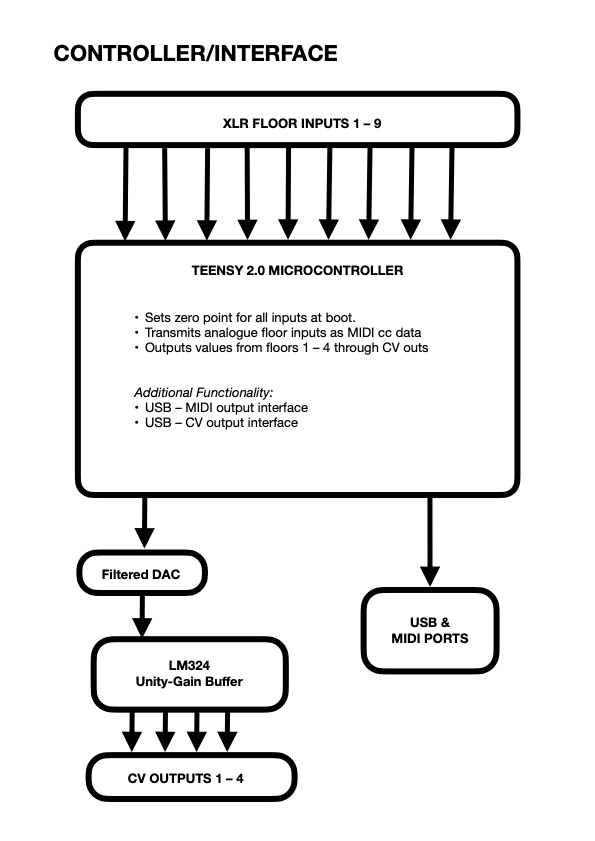The Terpsichora Pressure-Sensitive Floors
The tangram set of pressure-sensitive floors
The Pressure-Sensitive Floors
The terpsichora pressure-sensitive floors (The Floors) are a set of wooden platforms with sensors which respond to movement and pressure, facilitating music-making via whole-body movement. The Floors are primarily used for performance of composed and improvised electronic music.
They are made as part-replicas of Vernus floors, originally designed for the Australian pioneering dancer Philippa Cullen (1972). The Floors were developed in collaboration with Sebastian Collen and Mold Design Studio and have been part of wide-ranging works including solo performances, hybrid instrumentation chamber works, collaborations with dancers, installations and long-form works.
My current performance practice focuses on a versatile language of sound and movement that facilitates performance in wide-ranging improvisational settings, in groups such as Structures of Change. See the music page on this site for other works made with the Floors. I was a finalist in the Guthman Prize for Musical Instruments in 2023.
The research and expansion of the repertory for the Floors is ongoing.
Projects include Diametric Convergences with cellist David Moran on developing a suite of new works and a notational system that facilitates our collaborative work. Interconnectica, in collaboration with Sebastian Collen explores compositional possibilities of The Floors in combination with decontextualised organ pipes and interactive visuals. Solo performances can be found on my YouTube channel.
Utter:Stories, which was based on Philippa Cullen’s ideas, premiered during Adelaide Fringe 2021 with Cazna Brass, Derek Pascoe, Dylan Crismani and Sebastian Collen and is scheduled for repeat performances. The Floors were a part of a collaborative performance in 2018 at the Nexus Arts Centre with Parvyn Singh, Rachel Johnston and Erkki Veltheim.
Ocean, Again (2023)
Ocean, Again, Iran’s first solo album on the Floors, will be released on June 16, 2023.
This solo performance at CCRMA Live served as a (pre-) launch for this album.
Guthman Prize Finalist Concert
The Floors were a finalist in the Guthman Musical Instrument Prize in 2023. Following the day of judging and panels, there was a collaborative concert developed by each finalist with an Atlanta musician. The short piece developed with Nicolette Cash (saxophone) was a play on Brahms’ Horn Trio Op.40. Watch the concert here
Axes (2022)
In Axes, Iran uses her pressure-sensitive floors to control synthesis and sampling parameters in this process-driven piece. The performance draws out artefacts of audio as focal points of the composition and aims to connect movement of the body to indirect control of sound. This work uses simple synthesised tones in combination with processed samples for a slowly evolving set of possibilities which the performance navigates through.
Layout and sensor design
Each floor has a load cell underneath it, measuring the total flex of the wooden plate on top. The animation below demonstrates the internal structure of each floor.
Hardware design, information and animation bySebastian Collen
At the bottom of each floor, a load cell is attached to an aluminium bar, fastened to the plate. The load cell measures the flex of the wood, which changes a control voltage. This CV signal is amplified and digitised to MIDI CC and MIDI pitchbend values via a Teensy chip, after which it interfaces with the computer and MIDI devices. The output from the sensors below each floor connect to the Teensy via a control box and an XLR cable. The sensor has three connection pins: ground, 3 volt power, and its output signal. These pins are connected via an XLR plug, allowing each floor to connect to the teensy box with a standard XLR cable. The control box allows for 9 XLR inputs from floors, and duplicates the first four to be available as CV outputs directly from the box itself. These 4 CV outputs facilitate direct interfacing with hardware electronics such as modular synthesisers.
Floors sensor diagram, courtesy of Sebastian Collen
Floors controller diagram - image courtesy of Sebastian Collen
Hardware features
(Sebastian Collen)
Detecting the flexion of the wooden platform, rather than the direct weight applied, provides more organic nuances for the performer. This is achieved through an inverted application of a load cell to sense the “stretch” of the underside of the platform.
Referencing the original design of Cullen, the floors’ outputs are completely analog (CV), allowing for versatile legacy interfacing options. However, internally, the sensing is digitally controlled, providing temperature compensation, auto-calibration and uniform scaling. These make the floors as accessible and easy to use as possible.
The platform lighting is directly proportional to its flexing, and can be set to be inversely proportional as needed. This provides valuable visual feedback to performers, especially in situations where the audible response to the floor signals may not be linear. It also adds a visual cue to the floor’s performance as seen from the audience.
The controller interface for the system continues to be updated, and currently supports a range of MIDI options for interfacing with a computer, as well as CV outputs for direct connection to analog synths. By default the controller provides MIDI cc data over both USB and hardware ports, and is capable of providing 10-bit resolution via USB MIDI pitchbend. It supports nine floor input channels and four CV outputs.
This instrument was initially designed in 2015 and submitted along with a SuperCollider-based synthesiser as a part of an Honours Degree of a Bachelor of Music (Sonic Arts). The video of the first live performance, featuring dancers from the Australian Dance Theatre, can be found here.



